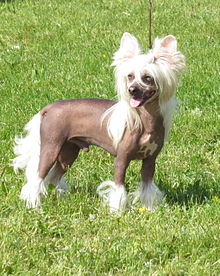Chinese Crested Dog

Hairless Chinese crested dog standing
|
||||||||||||||||||||||||||
| Common nicknames | Crested, Puff, Curtis | |||||||||||||||||||||||||
|---|---|---|---|---|---|---|---|---|---|---|---|---|---|---|---|---|---|---|---|---|---|---|---|---|---|---|
| Origin | China, Great Britain, Mexico | |||||||||||||||||||||||||
| Patronage | Great Britain | |||||||||||||||||||||||||
|
||||||||||||||||||||||||||
| Domestic dog (Canis lupus familiaris) | ||||||||||||||||||||||||||
| Classification / standards | |||
|---|---|---|---|
| FCI | Group 9, Section 4 Hairless Dogs #288 | standard | |
| AKC | Toy | standard | |
| ANKC | Group 1 (Toys) | standard | |
| CKC | Group 5 (Toys) | standard | |
| KC (UK) | Toy | standard | |
| NZKC | Toy | standard | |
| UKC | Companion Breeds | standard | |
The Chinese crested dog is a hairless breed of dog. Like most hairless dog breeds, the Chinese crested comes in two varieties, with and without fur, which are born in the same litter: the Powder Puff and the Hairless.
This breed is considered small; 10–13 lb (4.5–5.9 kg).
At first look, the Hairless and Powderpuff varieties of Chinese crested Dogs appear to be two different breeds, but hairlessness is an incomplete dominant trait within a single breed. The Hairless has soft, humanlike skin, as well as tufts of fur on its paws ("socks") and tail ("plume") and long, flowing hair on its head ("crest"). In addition to being an incomplete dominant gene, the "hairless" gene has a prenatal lethal effect when homozygous. Zygotes affected with double hairless genes (1 in 4) never develop into puppies, and are reabsorbed in the womb. All hairless Cresteds are therefore heterozygous.
The Hairless variety can vary in amount of body hair. Fur on the muzzle, known as a beard, is not uncommon. A true Hairless often does not have as much furnishings (hair on the head, tail, and paws). The difference between a very hairy Hairless and a Powderpuff is that the Hairless has a single coat with hairless parts on the body, while the Powderpuff has a thick double coat. The skin of the Hairless comes in a variety of colors, ranging from a pale flesh to black. Hairless cresteds often lack a full set of premolar teeth, but this is not considered a fault.
A Powderpuff has a long, soft coat. Both Hairless and Powderpuff varieties can appear in the same litter. The look of the Powderpuff varies according to how it is groomed. When its fur is completely grown out on its face, it strongly resembles a terrier; however, the Powderpuff is usually shaved around the snout as a standard cut. The Powderpuff Chinese Crested is an elegant and graceful dog who makes a loving companion, playful and entertaining. The Puff's coat is long and silky soft. Ears are large and erect.
The amount of body hair on the hairless variety varies quite extensively, from the true hairless which has very little or no body hair and furnishings, to what is called a 'hairy hairless', which if left ungroomed often grows a near-full coat of hair. These hairy hairless are not a mix between powderpuffs and hairless Chinese cresteds, but are merely a result of a weaker expression of the variable Hairless gene. The mutation responsible for the hairless trait was identified in 2008.
...
Wikipedia
